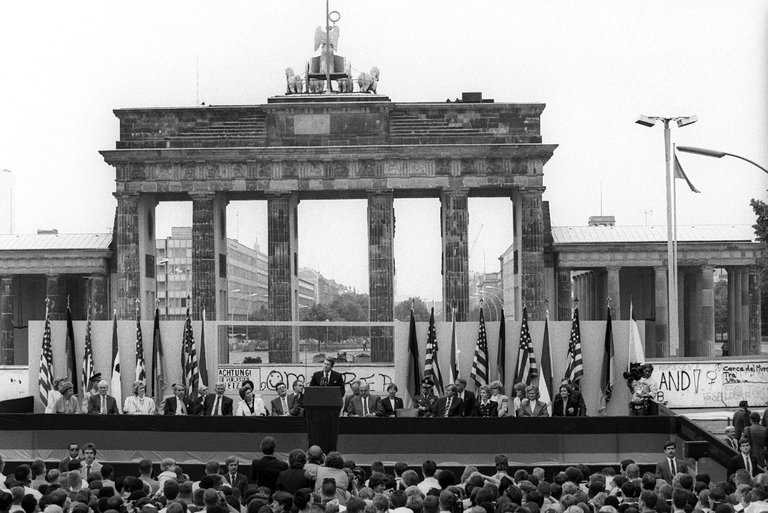
The staging was powerful: a United States president in front of the Brandenburg Gate at the height of the Cold War, with an East Berlin security post visible behind him.
On this day 30 years ago, President Ronald Reagan stood behind two panes of bulletproof glass 100 yards from the Berlin Wall and called on the Soviet leader Mikhail S. Gorbachev to dismantle it.
“General Secretary Gorbachev,” he said, “if you seek peace, if you seek prosperity for the Soviet Union and Eastern Europe, if you seek liberalization: Come here to this gate! Mr. Gorbachev, open this gate! Mr. Gorbachev, tear down this wall!”
The wall — which had divided the German capital since 1961 — was a physical and metaphorical symbol of the ideological and economic differences that separated the East and the West.
Reagan’s speech, emphasizing freedom and reunification, deliberately asked for more than Gorbachev would stretch to, which The Times saw as an effort to undercut Europe’s perception of the Russian as a leader of peace. (The Soviet press agency Tass called it an “openly provocative, warmongering speech.”)
Gorbachev had been instituting his Glasnost, or openness, policy, which facilitated freedom of discussion and information, and liberalized both the economy and the Soviet leadership structure.
Reagan chose the site for his challenge carefully. His speech noted that Presidents John F. Kennedy and Jimmy Carter had also visited the wall.
“We come to Berlin, we American presidents, because it is our duty to speak in this place of freedom,” Reagan said.
A little more than two years later, on Nov. 9, 1989, East and West Germans converged on the wall and began dismantling it after East Germany lifted travel restrictions. The country was reunified less than a year later.
The effects of Reagan’s speech have since been debated among political commentators and historians, who note that it received relatively little coverage in the news media at the time. Initial drafts met resistance within the White House, and the call to tear down the wall did not appear until later versions.
John Kornblum, a former United States ambassador to Germany, noted that the speech was not elevated to its current status until 1989, after the wall fell.
This article has been adapted from the Back Story of our Morning Briefing, which you can sign up to receive free, by email. We have briefings timed for the Americas, Australia, Asia and Europe.
The staging was powerful: a United States president in front of the Brandenburg Gate at the height of the Cold War, with an East Berlin security post visible behind him.
On this day 30 years ago, President Ronald Reagan stood behind two panes of bulletproof glass 100 yards from the Berlin Wall and called on the Soviet leader Mikhail S. Gorbachev to dismantle it.
“General Secretary Gorbachev,” he said, “if you seek peace, if you seek prosperity for the Soviet Union and Eastern Europe, if you seek liberalization: Come here to this gate! Mr. Gorbachev, open this gate! Mr. Gorbachev, tear down this wall!”
The wall — which had divided the German capital since 1961 — was a physical and metaphorical symbol of the ideological and economic differences that separated the East and the West.
Reagan’s speech, emphasizing freedom and reunification, deliberately asked for more than Gorbachev would stretch to, which The Times saw as an effort to undercut Europe’s perception of the Russian as a leader of peace. (The Soviet press agency Tass called it an “openly provocative, warmongering speech.”)
Gorbachev had been instituting his Glasnost, or openness, policy, which facilitated freedom of discussion and information, and liberalized both the economy and the Soviet leadership structure.
Reagan chose the site for his challenge carefully. His speech noted that Presidents John F. Kennedy and Jimmy Carter had also visited the wall.
“We come to Berlin, we American presidents, because it is our duty to speak in this place of freedom,” Reagan said.
A little more than two years later, on Nov. 9, 1989, East and West Germans converged on the wall and began dismantling it after East Germany lifted travel restrictions. The country was reunified less than a year later.
The effects of Reagan’s speech have since been debated among political commentators and historians, who note that it received relatively little coverage in the news media at the time. Initial drafts met resistance within the White House, and the call to tear down the wall did not appear until later versions.
John Kornblum, a former United States ambassador to Germany, noted that the speech was not elevated to its current status until 1989, after the wall fell.
This article has been adapted from the Back Story of our Morning Briefing, which you can sign up to receive free, by email. We have briefings timed for the Americas, Australia, Asia and Europe.
We’re interested in your feedback on this page. Tell us what you think.



























